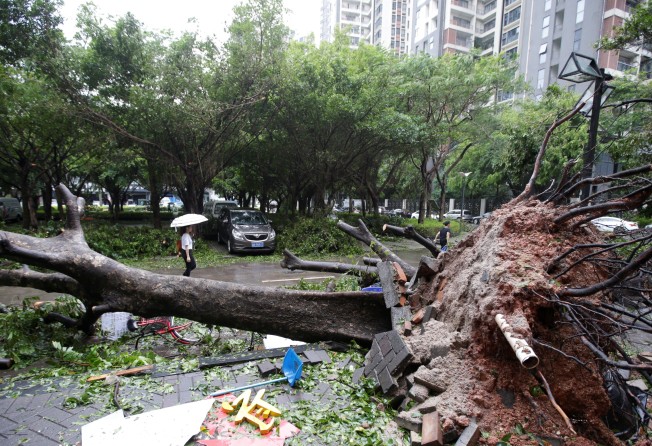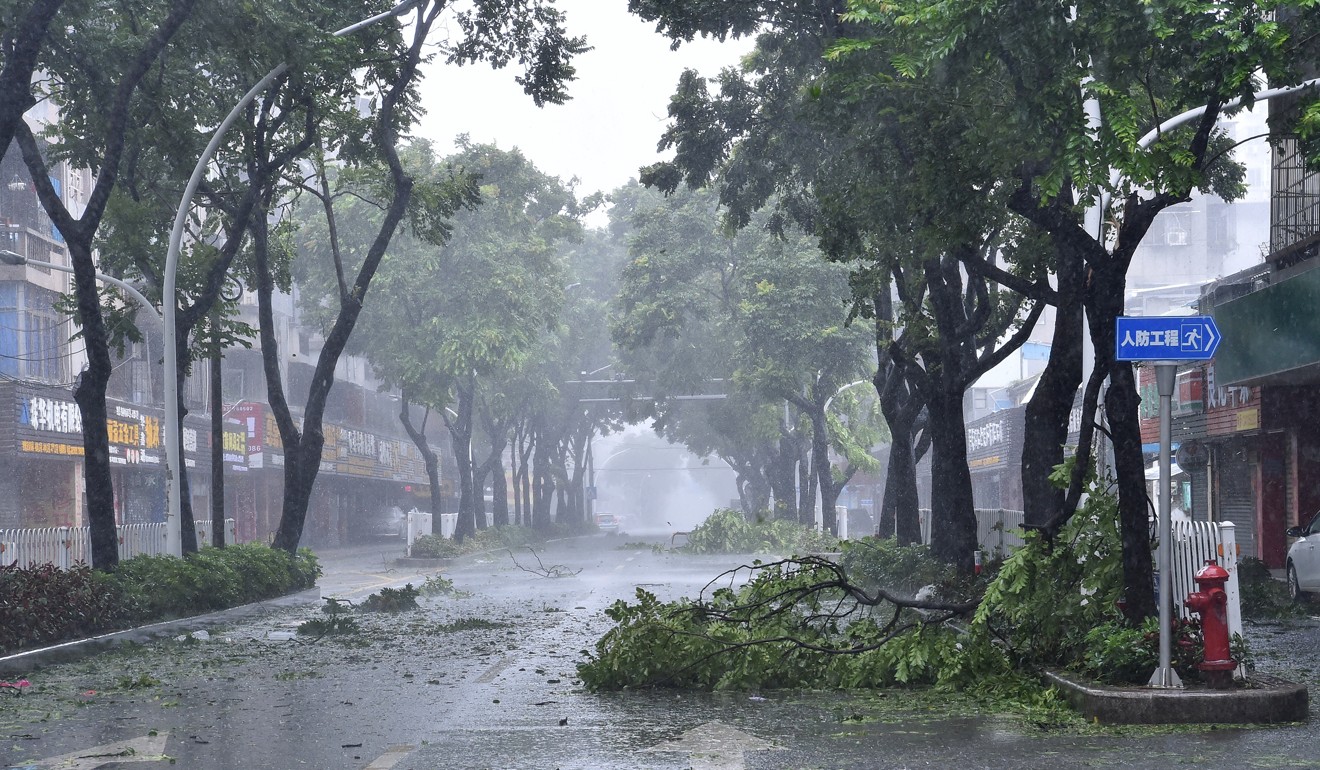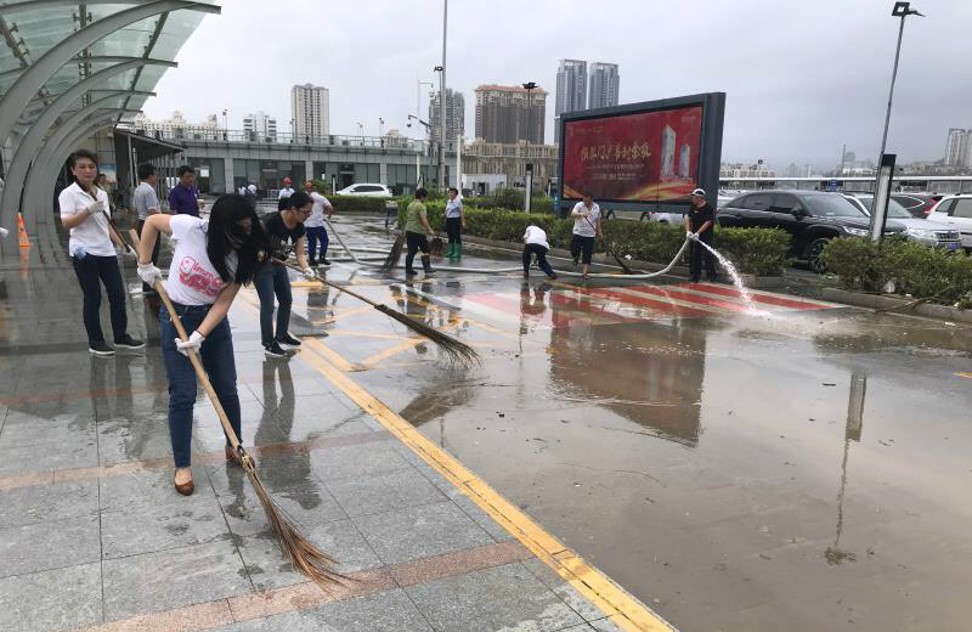Typhoon Mangkhut: four dead in southern China, residents warned to remain alert
The clean-up begins as China’s southern provinces assess the damage of the biggest tropical storm of the year

At least four people have been killed in southern China after Typhoon Mangkhut, the most powerful tropical storm to hit the county this year, barrelled into the southern province of Guangdong, the local government said on Monday.
Three people were killed by falling trees in the provincial capital Guangzhou while another person died after being hit by an advertising hoarding that collapsed in Dongguan, the state-run People’s Daily reported.
About 3.1 million people were evacuated before the typhoon hit, according to local newspaper Nanfang Daily, while state television said that more than 500,000 people had been affected by the storm.
Mangkhut made landfall in western Guangdong on Sunday afternoon before moving into the neighbouring Guangxi Zhuang autonomous region about midnight.
While the worst of the high winds appear to have passed, meteorological authorities warned residents to remain alert to the risk of floods and landslides.
In Guangzhou, Baiyun International Airport service resumed at 8am on Monday, but passengers were advised to check with their airlines about possible changes to flight information.
Other airports in the Pearl River Delta, including Shenzhen and Zhuhai in Guangdong, also reopened on Monday – having been closed all day Sunday.
The picture was less rosy in the Guangxi capital Nanning, where more than 70 flights had been cancelled as of 9.30am as the region continued to feel the effects of the storm.

The unopened Hong Kong-Zhuhai-Macau bridge was unaffected by the storm, Nanfang Daily said, citing the bridge’s management authority.
Before the typhoon, there had been concern that the bridge, which snakes through the Pearl River estuary, would not be able to withstand Mangkhut’s onslaught.
The bridge has a design lifespan of 120 years and is built to withstand winds of up to 200km/h (125mph).
Ferry services in the Pearl River Delta were also disrupted on Monday, with all sailings into and out of Shekou in Shenzhen and Jiuzhou in Zhuhai suspended.
Several through train services between Guangzhou and Hong Kong were also cancelled due to disruption of services on Hong Kong’s East Rail Line, which uses the same track.
As people took to the streets of Zhuhai to clean up the mess, residents said the city had fared better than it did when Typhoon Hato struck in August last year.
“Last year lots of large trees fell along this road,” a city cleaner surnamed Zhu said, as government workers, police and volunteers worked around him, dragging away palm tree leaves and loading them on to trucks.
“This year, we trimmed some of the larger trees beforehand. Right now all this damage is from smaller bushes and gardens.”

Bulldozers scooped up piles of dirt washed ashore by the flood on Lovers’ Road, a scenic promenade along the coast lined with resorts and parks. Damage could also be seen on parts of the stone barriers along the shore, where littered stones lay on the roads.
Shop owners in the area were mopping their floors and cleaning windows, getting ready to open for business later in the day.
A seafood restaurant employee, who asked not to be named, said she thought the government was better prepared this time, having learned from last year’s experience.
“We lost power for a few days last year, but no such thing happened this year,” she said. “The government also informed us beforehand. They even sent someone to brace this trash can in front of the shop.”
A taxi driver said Hato took everyone by surprise. “People had no idea it was going to be so powerful,” he said, and the government “did not take any precautions”.
It had been quite chaotic the day after Hato, but this time things got back to normal much quicker, he said.
In cities across the delta, however, the trail of destruction left by Mangkhut was clear to see, with broken glass and other debris strewn across roads and pavements.
In many areas, commuters had to negotiate fallen trees that had blocked roads and footpaths.
“It’s like going through a forest to reach your office,” a teacher at South China Agricultural University in Guangzhou was quoted as saying by Southern Metropolis News.
Authorities in Guangdong said the storm caused direct economic losses of at least 200 million yuan (US$29 million).
In Shenzhen alone, flood damage caused to about 10,000 vehicles had resulted in insurance claims for more than 84 million yuan, the Southern Metropolis News report said.
In Guangzhou, hundreds of shops at the Fangcun wholesale tea market, the largest of its kind in southern China, were badly damaged by heavy flooding on Sunday, and owners were counting the cost.
“The place was awash with waterlogged tea products,” said Liu Zhenhua, who has a business at the market.
“A century-old 20-gram packet of puer tea sells for several thousand yuan. Can you imagine how much the losses will be?” he said.
Jun Li, who operates several swimming pools in Guangzhou’s Panyu district said the cost of the damage to his business was at least 50,000 yuan.
In Jiangmen in southwestern Guangdong, the city government said the typhoon had affected about 123,000 residents and caused direct economic losses of more than 1.8 billion yuan.
Additional reporting by Xie Yu and Guo Rui

